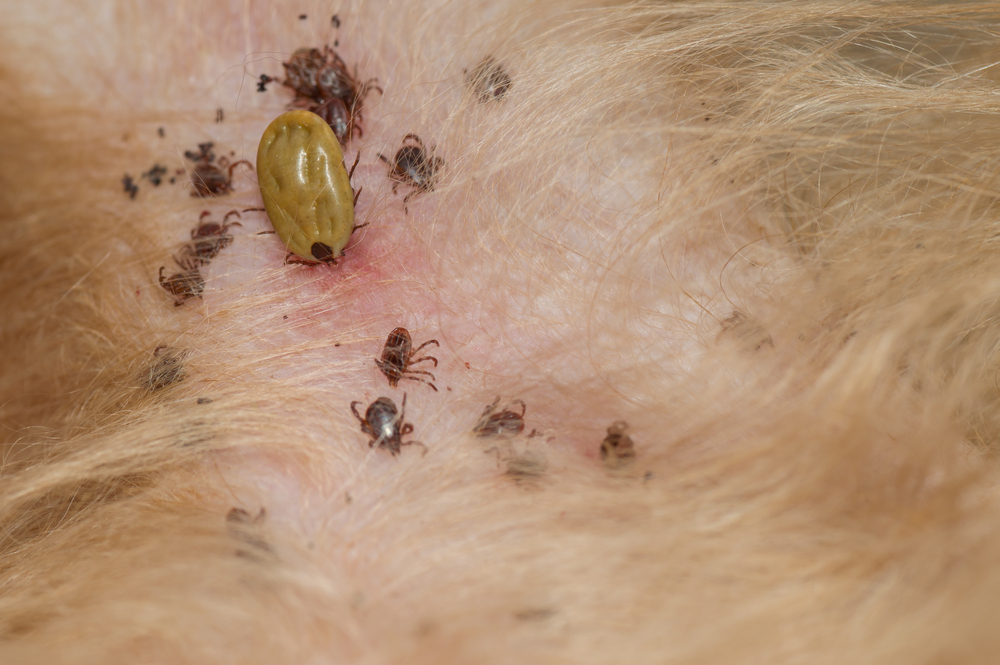Springtime brings some wonderful things—flowers, sunshine, and a long-awaited respite from the winter cold. However, spring also brings an increase in tick activity, endangering your pet’s health, since ticks are well-known disease vectors, and our low-to-the-ground pets are prime targets. March is the Canadian Veterinary Medical Association (CVMA) National Tick Awareness Month, so your North Waterloo Veterinary Hospital team wants to answer your tick-related questions to keep your pet safe this spring, and all year long.
Question: What exactly are ticks?
Answer: Ticks are parasitic arthropods that live freely in the environment most of their lives, but attach to a host, such as a person, pet, or wildlife, for a blood meal, to molt through each life stage. They hatch in the environment from eggs to six-legged larvae, feed and molt into eight-legged nymphs, and finally feed and molt into a larger adult. Females feed again to mate, and die shortly after laying eggs. The entire tick life cycle lasts around three years, with most ticks surviving winters in a dormant state. Many tick species exist in North America, and their ranges are constantly evolving.
Q: What time of year are ticks most active?
A: Don’t be fooled into believing that your pet is safe from ticks in the wintertime. Tick activity does have some seasonality, but temperature and day length are the driving factors. The American dog tick becomes active in the spring and summer when days become longer, but the black-legged (i.e., deer) tick can become active anytime the temperature rises above freezing, and is most active during the fall and early winter. The brown dog tick can infest buildings, so may be active year-round. As a general rule, the worst tick seasons are spring and fall, but ticks are active all year.
Q: Where could my pet be exposed to ticks?
A: Ticks like wooded areas, leaf litter, and tall grasses. They venture up from the ground to find their hosts—they do not fall from trees, contrary to popular belief. You can expect them in areas frequented by wildlife, but they can also venture into neighborhoods, cities, and backyards. In the case of the brown dog tick, large numbers of dogs housed in kennels and homes can attract these pests.
Q: Are ticks a threat to my pet?
A: Yes, absolutely. Tick bites can cause local or systemic allergic reactions and infections, and tick saliva toxins can cause a rare syndrome called tick paralysis. However, the biggest threat that ticks pose to your pet’s health are tick-borne diseases, a host of illnesses that can be transmitted through a tick’s bite. Diseases can pass from tick to host in as little as three hours after attachment, or take up to 48 hours for transmission. Common tick-borne diseases affecting pets in our area include:
- Lyme disease — Lyme disease is caused by a spirochete bacteria and causes joint inflammation, fever, and lethargy, and can affect the kidneys. The most common presentation for Lyme disease is a “shifting-leg” lameness, in which your pet may be limping on one leg for a few days, followed by a limp on a different leg.
- Ehrlichiosis and anaplasmosis — These bacteria can cause fever, lymph node swelling, and low platelet counts. Chronic cases can result in organ enlargements, severely low platelets, eye inflammation, meningitis, and kidney failure.
- Rocky Mountain spotted fever — This disease is caused by rickettsia bacteria that can cause severe signs, such as high fever, swollen joints, enlarged lymph nodes, organ damage, and bleeding problems, and has a mortality rate of up to 10% of infected dogs.
Ticks that are capable of producing disease in your pets can also bite you and other household members. Pathogenic organisms transmitted by ticks produce different diseases in humans versus pets, but all ticks have the ability to make you or your pets sick.
Q: How can I protect my pet from ticks?

A: Prevention is key to protect your pets—and yourself—from tick-borne diseases. Here are the proactive steps you can take for your pet’s health:
- Use a preventive regularly — Tick preventives are products that you apply to your pet’s skin, or give orally every one to three months. They are typically prescribed by your veterinarian, and are a safe, effective, easy way to protect your pet, and work by killing attached ticks. Some topical products have a repellent effect, which may help keep ticks off your pets in the first place. Talk with your veterinarian to see which product is right for your pet.
- Avoid tick-heavy areas — During spring and fall, avoid letting your dog play in tall grasses or wooded areas. Keep your yard clear of leaf litter and your grass cut short. If you walk through wooded areas with your pet, stay in the center of the trail.
- Check your pet for ticks regularly — Using a preventive product is the best method to protect your pet, but a tick may take several hours to die after attaching, and they can transmit diseases during this time. Check your pet for ticks when you come inside, and remove any you find. Do not burn ticks or use any method other than gently pulling the tick out with an appropriate tool—ask your veterinarian to show you how.
- Consider the Lyme vaccine — If your dog frequently encounters ticks, consider protecting them with the Lyme disease vaccine that works against the bacteria that cause Lyme disease. However, despite the vaccine, you’ll still need to use tick preventive measures to ensure your pet does not contract any other tick-borne diseases.
- Screen for tick exposure yearly — If your pet is regularly exposed to ticks, you should screen for tick-borne diseases yearly. Your veterinarian can perform this test at the same time as your pet’s yearly heartworm test, and, if exposure is found, they can advise whether treatment or further testing is indicated.
Ticks can be a danger to you and your pets, but with proper preventive measures, you can safely enjoy the outdoors year-round. If you need help choosing a tick prevention product, advice on how to properly remove ticks, or think your pet may have been exposed to a tick-borne disease, call us to schedule an appointment with your knowledgeable North Waterloo Veterinary Hospital team.







Leave A Comment